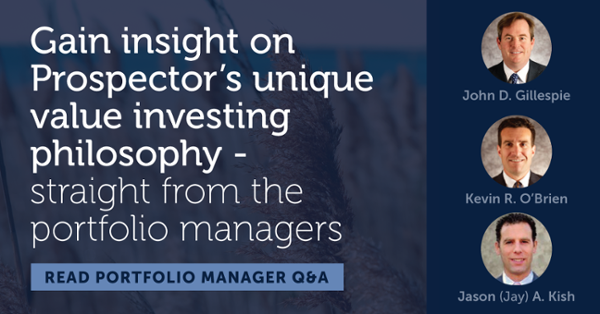Since investing throughout the financial services sector is a specialty of ours, here is an update on where things stand on an industry-by-industry basis, including where we’re seeing opportunities.
Property and Casualty Insurers
Property and casualty underwriter stocks have been harshly punished by the market over concerns of potentially having to pay COVID-19 related claims under business interruption clauses in their commercial property policies as well as plummeting yields on fixed income investments hurting reinvestment rates and slowing book value growth. While there is truth to the latter concern, we feel that the first one, which is the more material, immediate concern, is unfounded.
Our property and casualty holdings generally consist of personal lines insurers who have little commercial property exposure, or main street carriers who write small commercial policies largely using Insurance Service Office (ISO) standard forms which specifically exclude coverage for a pandemic. While not unusual for politicians to propose legislation in the aftermath of a large loss to extend insurance policies to respond to events specifically excluded (e.g. Hurricane Sandy, World Trade Center, et al), the U.S. judicial system has always ultimately enforced the principles of contract law. We feel strongly that this will remain the case.
Reinsurance industry exposure to Covid-19 is difficult to handicap, and it could affect several reinsurance companies negatively. However, we believe reinsurers who are mainly exposed to catastrophe reinsurance, a class of contracts with less COVID-19 exposure, to have manageable losses.
Insurance Intermediaries
This is another area we like. These companies stand to benefit from dramatically higher future rates for insurance which are in the offing. These capital-light businesses charge commissions and fees and bear no underwriting risk. We expect organic growth to dip in the next couple of quarters as the headcount-related premium lines such as workers compensation contract with rising unemployment, before reaccelerating into an economic recovery as insurance rates accelerate.
Banks
On the bank side, we reduced exposure due to a decent rally in bank stocks during the fourth quarter of 2019 combined with twin concerns about an overdue credit cycle and a persistent low interest rate outlook. Today, banks in the U.S. are better prepared to handle this crisis than in 2008.
- Banks have significantly higher capital levels and liquidity, plus many of the higher risk loan categories are now held by non-bank lenders, hedge funds, etc. In other words, the capital ratios relative to risk assets are double where they were prior to the Great Financial Crisis, and the loan underwriting standards are significantly more stringent than 12 years ago.
- They also hold fewer exotic instruments and engage in significantly less proprietary trading.
- Banks’ digital capabilities, built through large consistent investing in technology over the past decade, allow them to service customers seamlessly and remotely, which is currently essential.
- Bank stocks are historically inexpensive on a price to tangible book value basis and have robust 5% dividend yields that look sustainable unless the downturn becomes materially worse, or the Fed reverses their current stance and forces banks to cut dividends in an effort to accrete capital.
- Finally, regulators and legislators are using the banking infrastructure to deliver stimulus to small businesses, i.e. they are part of the solution, not the epicenter of the problem as during the Great Financial Crisis.
That said, banks have few safe haven loan categories this time around; especially at risk are loans in the energy, hospitality, restaurants, retail, travel, leveraged loans, etc. Also, buybacks are suspended for the time being, and M&A activity has halted as well, both of which are core elements of the book value growth thesis for owning bank stocks.
This is an excerpt of our Q1 2020 commentary. The full document, which includes our
Stock Market Distress Playbook, is available here.


